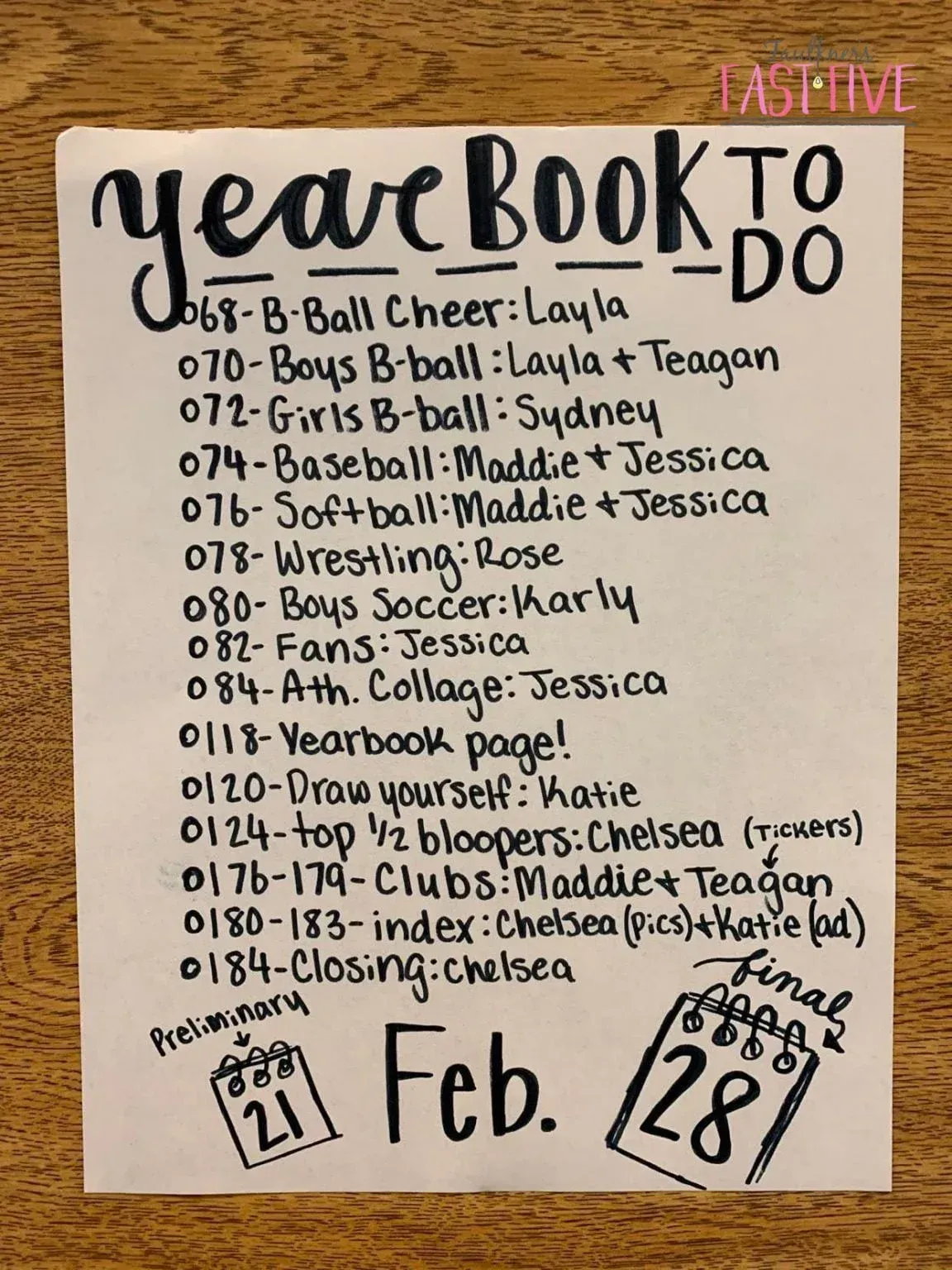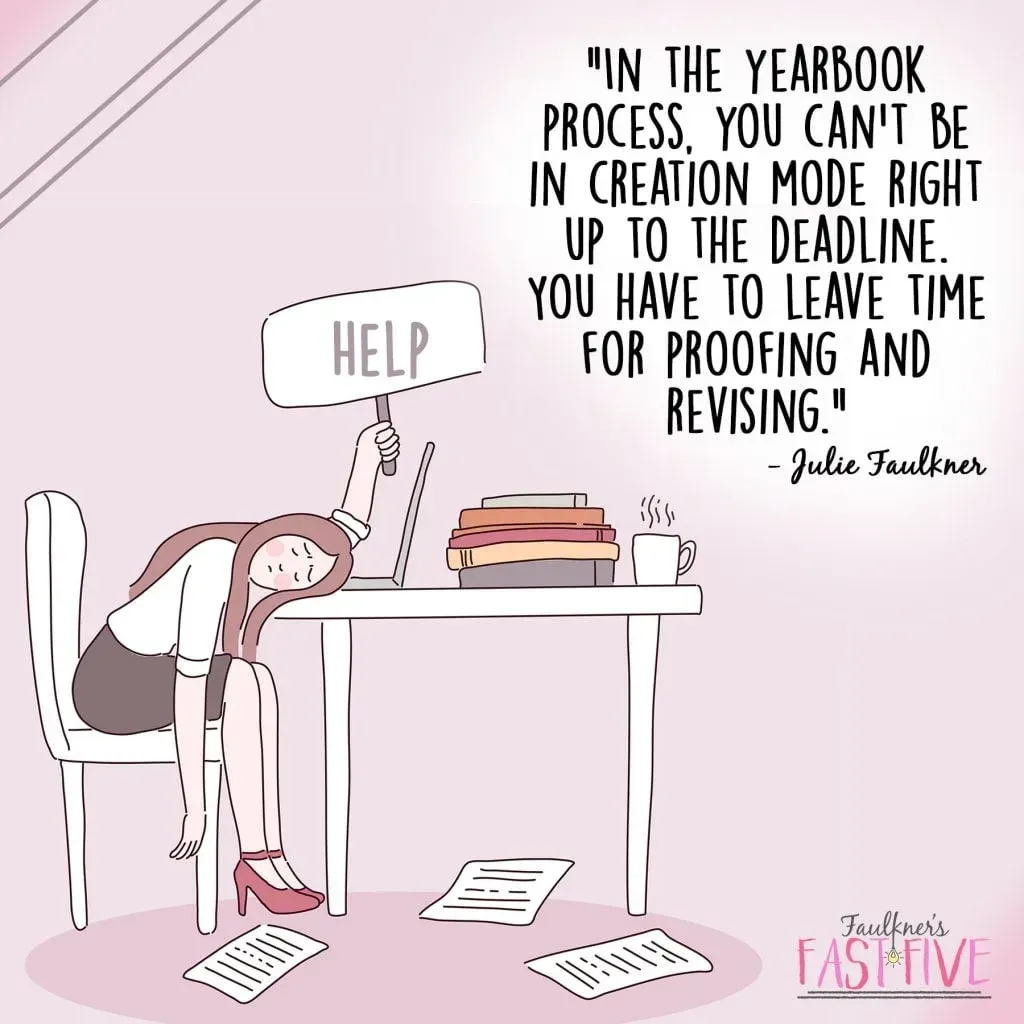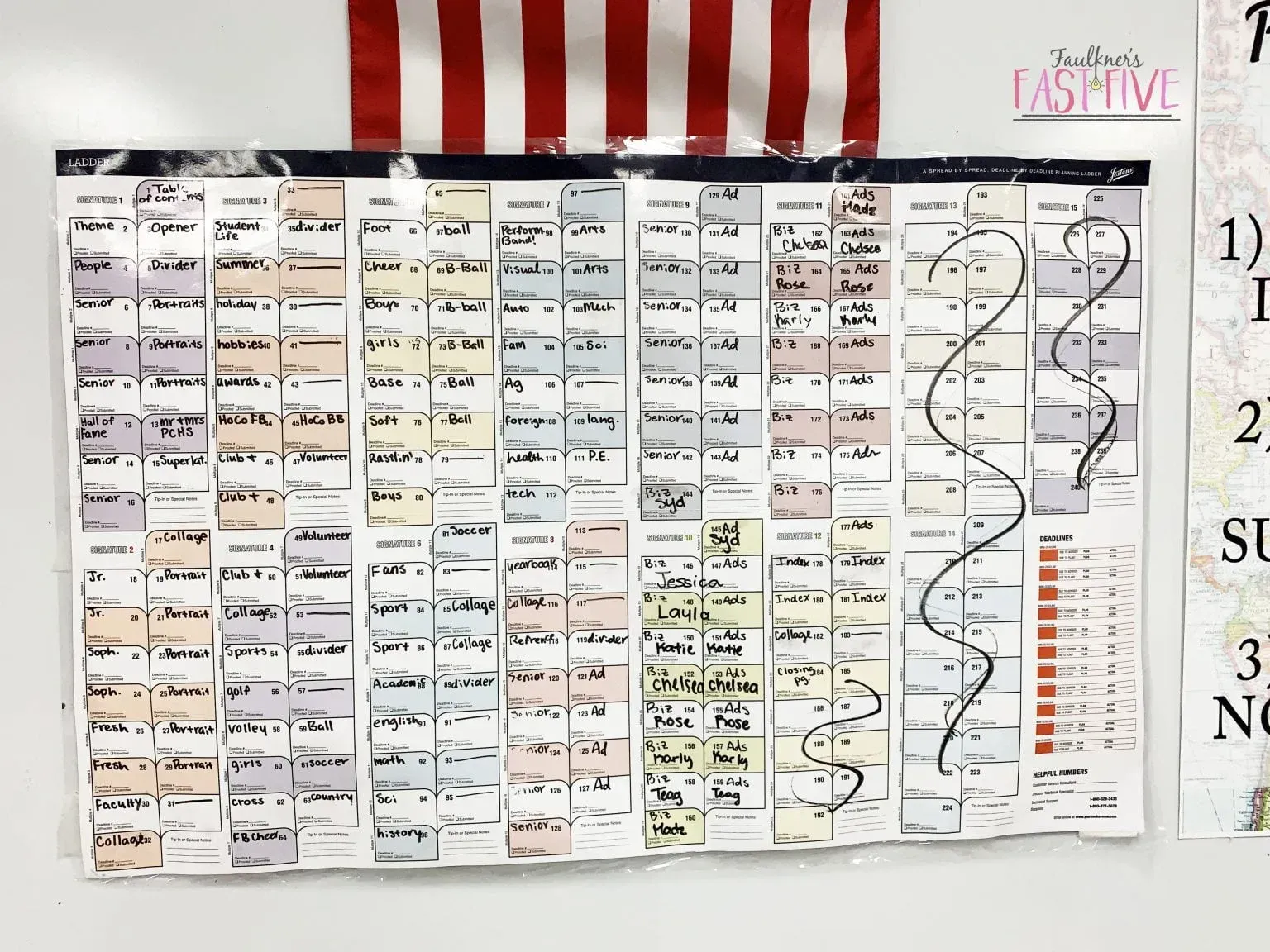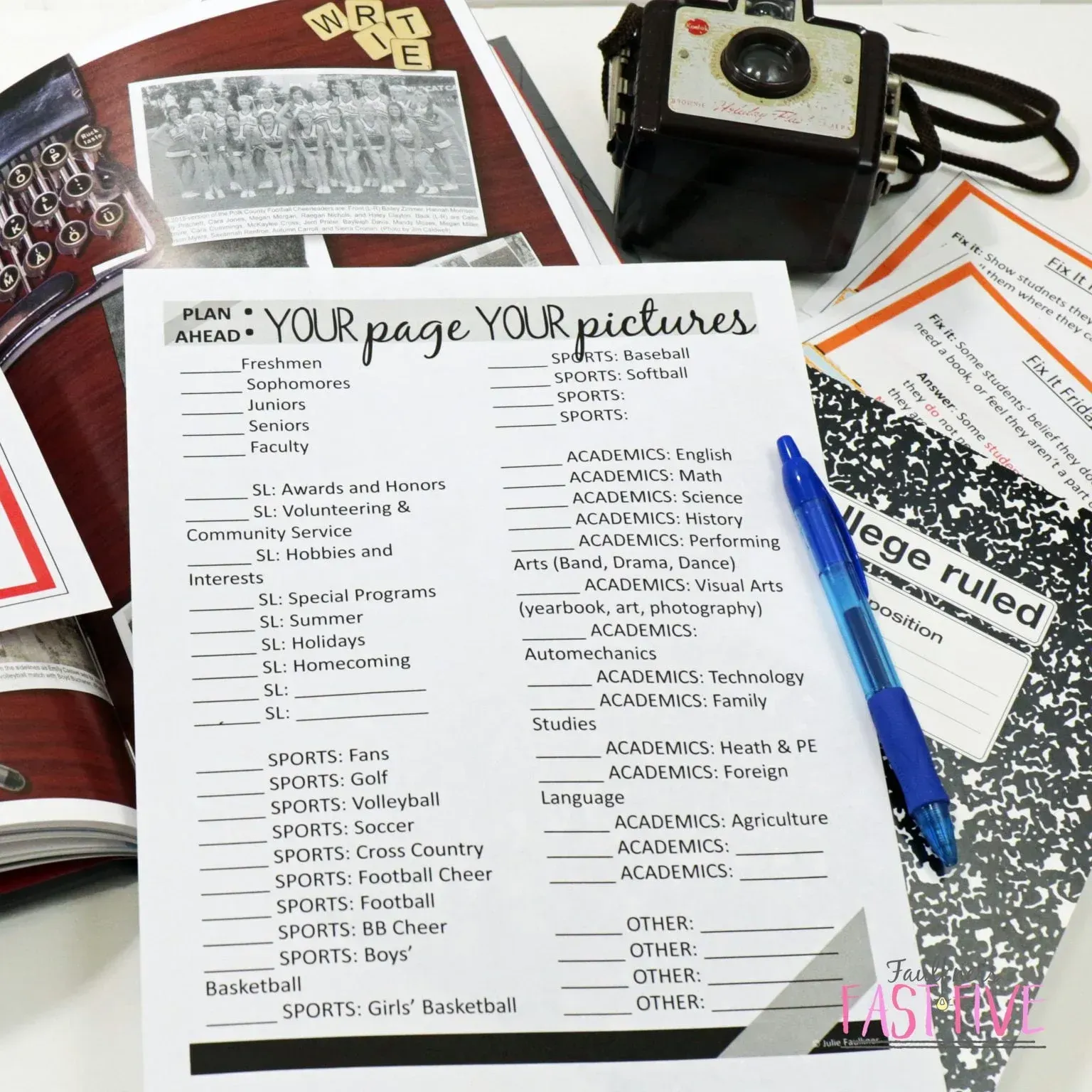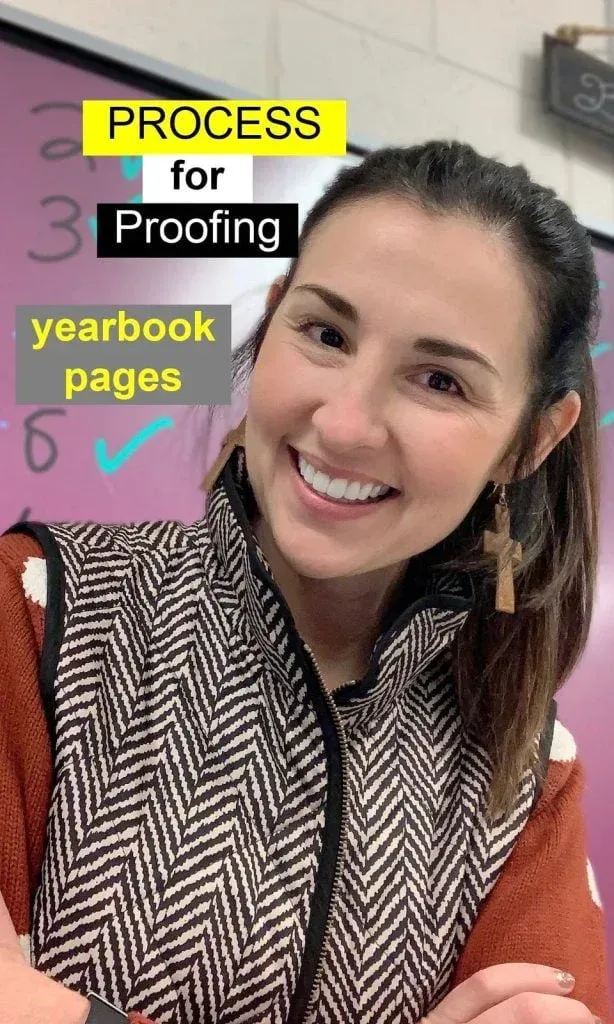Everything You Need to Know About
Meeting Yearbook Deadlines
One of the most daunting tasks of being a yearbook adviser is meeting deadlines. However, it is super important — always being front of mind. In fact, when I discuss the top five things a new yearbook adviser needs to do, finding out those deadlines makes the cut. Honestly, you can’t share the book with the world if you don’t meet the print deadlines! Making deadlines, though, is certainly more than just knowing when the deadlines are. It’s a process, and one that must be started on week one, or before. In this post, I’m sharing everything you need to know about meeting yearbook deadlines with my no-fail, step-by-step process!
1. SET BIG AND LITTLE YEARBOOK DEADLINES DURING THE FIRST WEEK
After you close your current year’s book, set up a date to meet with your publisher to determine dates for the upcoming year’s publication. It is really never too early to set deadlines. They are that big of a deal. Everything in the production of a yearbook hinges on meeting deadlines. Once you’ve decided if you are a spring, summer, or fall delivery book along with how many pages your book is, your publisher can tell you how many deadlines you will have throughout the year and how many pages per deadline you will need to submit. I take those deadlines and break them up even more for my staff. We have checkpoints along the way to each deadline with rubrics (included in my full yearbook curriculum), so that we never get to the last minute and have pages that aren’t done waiting on final proofs. For example, if the publisher says the hard deadline is Nov 20, then I might have two deadlines prior: Pre-Check on Nov 1; Mid-Check on Nov 10; and Final Check on Nov 18.
These mini deadlines are so important. I tell the students, “In the yearbook process, you can’t be in creation mode right up to the deadline. You have to leave time for proofing and revising.” If you don’t build in time for multiple checks, in my experience, you miss so much that could have been caught and corrected. Plus, deadlines offer a plan, and without a plan, a plethora of problems ensue. Creating a yearbook is hard enough without making it harder because you aren’t working with specific goals in mind.
2. PHOTO DATES AND AD COLLECTIONS NEED TO HAPPEN EARLY
The portrait pages and advertisement pages are two staple sections of a yearbook. Some may not have an advertisement section, but if you do, that section is usually at the end of the book; therefore, it is an easy first deadline because submitting pages at the end of the book first is safe as it won’t lock down other pages in the book that need to be more fluid throughout the creative process. Also, for a high school book especially, there are usually anywhere from 30-50 pages of business advertisements and senior tribute pages. That is typically enough to meet a publisher’s first deadline. If you are able to use your ad pages for your first deadline, that means you’ll need to assign business ads to staffers and advertise for senior tributes to families starting the first week of school. Another benefit of having students work on business ads first is that they are learning your company’s software, and it gives flexibility for you to teach crucial skills like photography and interviewing before the year really kicks off to full start.
The other section of the yearbook that can be simple to design and submit is the portrait section. However, deadlines are tricky with this section because you are likely depending on an outside photography company to take the photos, do make ups, and then get them to you. Also, you often have to send the yearbook-specific files (yes, that’s a thing) to your publisher. That’s an added step and more time you have to plan for. Again, in May or during the summer at the latest, you need to get your photo dates on the calendar. That will include multiple people in addition to the company and you: admin, counselors, coaches, and club sponsors. Consider these appointments, and schedule them within the first two (three at the latest) months of school:
- Senior Pictures
- Underclassmen Fall Pictures
- Senior Retake/Make Ups
- Underclassmen Retake/Make Ups
- Senior Cap/Gown
- Sports Groups and Individual (if your company does this) for fall and spring
- Superlatives
- Club Group Photos
3. SET UP THE LADDER AND ASSIGN PAGES EARLY
First, a ladder is the list of pages your book will have and what will be on each page. You can build a ladder on a poster, piece of paper, shared Google sheet, or with sticky notes. Tools to make a ladder are included in my full Yearbook Curriculum. However you build the ladder, it is imperative that you do so early and communicate it out to students.
The next step after getting the ladder as set as possible is to assign students their “beats.” Beat reporting is specialized reporting in a specific area, topic or subject. Below is an example of a handout that I use to assign the pages and sections. This one is for a book organized by sections, but if your book is chronological, you could tweak it enough to compensate for that. Assigning students their “beats” early prevents any “sneak up” moments when an event happens but doesn’t get the coverage it needs. This also helps staffers plan their own calendars, as yearbook students are often involved and busy outside of yearbook class.
It’s not always possible to foresee and plan every event, sports game, classroom experiment, etc; however, you can prevent a lot of stress and oversight by planning up front. With meeting yearbook deadlines, that’s the name of the game.
4. DEVELOP A PROCESS FOR PROOFING YEARBOOK PAGES
Since I am also an English teacher, proofing and revising is in my wheelhouse. However, there are a quite a few more moving parts in meeting a yearbook deadline with 40-something pages with captions, photos, tags, graphic elements, etc. than there are in a typical 1,000 word paper. That said, students also need an easy and effective process. I share my process in this Instagram video:
5. LEAVE YOURSELF ENOUGH TIME FOR FINAL SUBMISSION
Did you notice above in my deadline dates example that I don’t give students the final deadline as the publisher’s hard deadline? It is critical to leave yourself, as the adviser, time to make the final submissions. By the time we’ve gotten to the final deadline, I’ve seen the pages multiple times, but that doesn’t mean that the pages are perfect, unfortunately. I like to have one final look before I hit the submit button. Also, turning pages into the publisher on your software/website is likely not a one-click process either. In the Jostens program that we use, it is actually about three steps before you actually release the pages. That takes time. Several hours, in fact. Therefore, it’s basically impossible to meet the yearbook deadline (especially a hard deadline) if you allow your students to work on pages in creation mode until 3 pm. You’ll be proofing, spell-checking, replacing pictures, adding captions, and anything else your publisher’s software requires before you are done — and with 40+ pages for your deadline, midnight approaches quickly. Being a yearbook adviser is stressful enough without the added stress of not planning ahead to have extra days for submitting pages on final deadline days. Been there. Done that. And it isn’t fun, but more importantly, it doesn’t have to be that way. The old adage, “Work Smarter – Not Harder” most definitely applies to meeting those yearbook deadlines!
If you are a new yearbook adviser, check out my blog post here: Tips for New Yearbook Advisers. I also have a video for tips for getting your yearbook going over on my Facebook page. You can also get more great tips, freebies, and access to webinars for yearbook/journalism by joining my Yearbook Advisers Facebook Group. It’s free to join!
Love this content?
Sign up for my email newsletter with more tips, ideas, success stories, and freebies!





